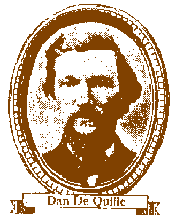The first-born of Virginia City The Towns of the Big Bonanza excerpted from The Big Bonanza by Dan DeQuille of the Territorial Enterprise |  |
The first-born of Virginia City The Towns of the Big Bonanza excerpted from The Big Bonanza by Dan DeQuille of the Territorial Enterprise |  |

As not much has yet been said in regard to the principal towns of the "big bonanza," I shall now devote a few chapters to Virginia City and Gold Hill, but more particularly to railroads, waterworks, lumber-flumes, and other things intimately connected with the growth and prosperity of theose towns and the cheap and economical working of the mines.
To begin, I may say that the two towns, Virginia City and Gold Hill, which were formerly over one mile apart, are now united, and the dividing line cannot be distinguished. The population of Virginia City ia a little over twenty thousand, and that of Gold Hill about tem thousand, according to the directory for 1875.
Virginia City, as had already several times been mentioned, lies along the eastern face of Mount Davidson, on a broad sloping plateau, and is surrounded on all sides by rugged hills and rocky mountain peaks. In the early days these hills were covered with a sparse growth of nut pine trees-- a sort of stunted pine, in size and form of trunk and branches somewhat resembling an ordinary apple tree-- but the demand for fuel for the mines, mills, and domestic uses swept all these away in a very few years, and even the stumps have been dug up and made into firewood by the Chinese.
Gold Hill is situated at the head of Gold Canyon on the south side of Mount Davidson, and is shut in by the walls of the ravine, along which stand the principal buildings of the town. A ridge about 200 feet in height lies between the two towns, which is known as the "divide." The divide is covered with buildings and is a fine airy location - a place where the Washoe "Zephyr" marches to and fro at will.
In 1859 there was some scattering nut pine trees on the sides of the mountains about Gold Hill, but these soon went the way of those about Virginia City, and now all the hills and mountains, as far as the eye can reach are brown and treeless. The only covering of either hills or valleys is the eternal and ever present sagebrush.
This shrub grows to a height of from one to four feet, and its leaves are not green, but of an ashen gray, much the color and much the same in shape as the leaves of the common garden sage. The botanical name of the shrub is Artemisia tridentata. Through this scanty covering of sagebrush the rocks every where rise up as though they might be the bones of the land peeping through its skin.
The first house built in Virginia City was a canvas structure, 18 by 40 feet in size, erected in 1859 by Lyman Jones, one of the pioneers of the country. Mrs. Jones was the first white woman who lived where Virginia City now stands, and her daughter, Ella, was the first white child seen in the camp. The first white child born in Virginia City was the daughter of J.H. Tilton, one of the pioneer wagon-road builders of the country. She was born on the first of April 1860 and was named Virginia. She still lives in the town in which she first saw the light.
In Virginia City are to be seen as many large and substantial buildings, both public and private, as in any town of like population on the Pacific Coast. The Catholics, Espiscopalians, Presbyterians, Methodists, Baptists, and other leading Christian denominations have fine and costly churches in the town, and these are as well attended as the churches in any other land. The Masons and Oddfellows have fine halls and both societies are in a very flourishing condition.
There are in the city most of the orders and societies found in other large towns as the Knights of the Pythias, ancient order of Druids, improved order of Red-men, Knights of the Red Branch, Champions of the Red Cross, Crescents, Irish Confederation, Ancient order of Hibernians, Caledonia Society, Society of Pacific Coast Pioneers, too Turnvereins, miners union, printers union and several similar societies.
In the way of benevolent associations there are they Virginia Benevolent Society, Italian Benevolent Society, Hibernian Benevolent Society, St. Vincent de Paul Benevolent Society and several others. In the city is St. Mary's Orphan Asylum and School (under the charge of the Sisters of Charity), built at the cost at about $100,000, and the St. Vincent Hospital, which cost $40,000 to $50,000. In the town are five military companies - the National Guard, Emmet Guard, Washington Guard, Montgomery Guard, and the Nevada Artillery.
In the several wards of the city are handsome, commodious, and comfortable schoolhouses, and there are several flourishing Sunday schools conducted under the auspices of various religious societies. The city is lighted with gas and is supplied with pure water from the Sierra Nevada mountains, and has telegraphic communication with all parts of the world.

Bridget E. Smith, editor & publisher
Email | Home Page | Dan DeQuille's Title Page
Historical Gazette
Published in Portland, Oregon
© 1991-